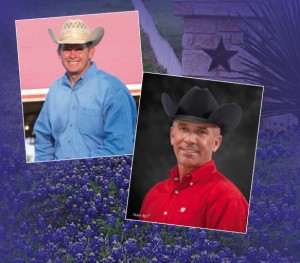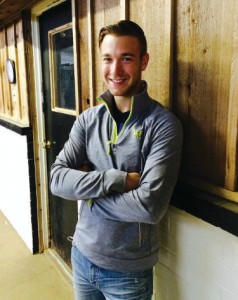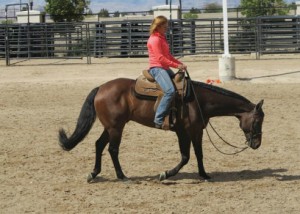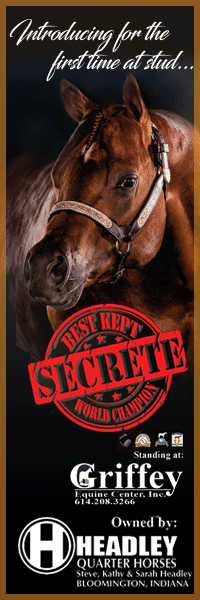Dry River Ranch – Terry Cross & Stephen Stephens
Click here to read the full article in our digital edition.
By Lauren Levy
 Dry River Ranch stretches across eighty acres of land in rural Weatherford, Texas. Owned and operated by AQHA Professional Horsemen Terry Cross and Stephen Stephens, this multi-purpose ranch stands stallions, foals out mares, and offers a complete horse training program. On average, there are nearly sixty horses on the property at any given time. Dry River Ranch is essentially a one-stop-shop for all things equestrian. This setup has brought great success to Cross and Stephens over the years. They currently stand stallions like The Mechanic, 2013 High Point Western Pleasure Stallion in the Nation; Spot My Blue Boy, 11-time Appaloosa World and National Champion and 2013 Appaloosa Horse of the Year; and IE Reason, four-time Top Ten World and Congress Champion. In addition, Cross and Stephens have aided well-known exhibitors like Bailey Anderson, Alyssa Hinchman, and Suzanne Randolph on their rise to the top of the AQHA show circuit for a number of years. With the help of three interns, Joanie Lebel, Kody Abendschein, and Mattias Hecht, and a number of farmhands, Cross and Stephens keep Dry River Ranch thriving. They found the time during their busy schedule to give The Equine Chronicle readers a peek inside their daily lives as equine professionals.
Dry River Ranch stretches across eighty acres of land in rural Weatherford, Texas. Owned and operated by AQHA Professional Horsemen Terry Cross and Stephen Stephens, this multi-purpose ranch stands stallions, foals out mares, and offers a complete horse training program. On average, there are nearly sixty horses on the property at any given time. Dry River Ranch is essentially a one-stop-shop for all things equestrian. This setup has brought great success to Cross and Stephens over the years. They currently stand stallions like The Mechanic, 2013 High Point Western Pleasure Stallion in the Nation; Spot My Blue Boy, 11-time Appaloosa World and National Champion and 2013 Appaloosa Horse of the Year; and IE Reason, four-time Top Ten World and Congress Champion. In addition, Cross and Stephens have aided well-known exhibitors like Bailey Anderson, Alyssa Hinchman, and Suzanne Randolph on their rise to the top of the AQHA show circuit for a number of years. With the help of three interns, Joanie Lebel, Kody Abendschein, and Mattias Hecht, and a number of farmhands, Cross and Stephens keep Dry River Ranch thriving. They found the time during their busy schedule to give The Equine Chronicle readers a peek inside their daily lives as equine professionals.
6:00 AM
Today, Cross and Stephens have a big day ahead of them. Cross is preparing to take horses on a 24-hour drive to Las Vegas for the annual AQHA Silver Dollar Circuit tomorrow. Stephens is completing tasks that are necessary to keep the management of the ranch and Dry River Ranch’s breeding program intact.
At 6:00 AM, Cross has just woken up for the day. On a typical morning, he admits that he usually watches a little TV and tries to develop a plan for what he wants to accomplish that day. He tries to be outside around 7:00 to 7:30 to start working with his horses. Once he arrives in the barn, his first task is to check in with the interns to make sure they are organized for the day. Also, he checks on each of the horses to make sure they are all well. However, Cross jokes, “This is kind of an unnecessary task, because if something was wrong with one of them, one of the interns would have already called me.” These morning rounds usually take about thirty minutes. By 8:00, Cross is ready to get on his first horse.
Meanwhile, Stephens has been in the barn since 6:30 this morning. Because today is a breeding day, he first checks the fax machine to see what semen requests he has received before going down to his lab. There, he turns on all of his equipment and gets ready to start collecting semen from the stallions on the ranch. However, before doing this, he also chats with the farmhands and interns to make sure they are all on track. Stephens explains, “Cross works more with the interns on their riding techniques, and I am more of the life lessons guy. For example, some days I will ask them to give someone a lesson, and I will tell them what I want their focus to be. When they are done, I want them to be able to explain why they taught what they taught.”
8:03 AM
By 8:03 AM, Cross is riding one of the more seasoned horses in the barn. Impulsive Lite, aka “Roanie,” is owned by the Hinchman family. “Roanie doesn’t work overly hard at home,” Cross says. “But, a couple days before a show, I will take him out and do a couple of lead changes on him to remind him that he has a job to do. This gets him in the right frame of mind for the horse show.”
After finishing his ride on Roanie, Cross then gets out another horse in the barn that’s going to the show in Las Vegas tomorrow. He intends to work on this bay gelding’s turns and the rating of his speeds through different horsemanship transitions. Cross explains that this is something the gelding and his rider often struggle with in the class. Cross shares a tip for such a horse and rider team that might be struggling with controlling their speeds at different gaits. “It’s good to practice at home by going many times around the pen and keeping your horse at different speeds,” he says. “Switch your horse between medium, fast, and slow paces until both you and your horse feel connected and comfortable at each pace.”
When getting ready to leave for a show, Cross likes to ride the horses he will be taking first, so they have time to be clipped and bathed. While Cross works with these show horses, Stephens is diligently collecting semen to fill the orders he received earlier in the day from breeders across the country. He explains, “I have to collect the semen, package it, and do the paperwork for everybody. Then, I have to give all of the information over to Sandy BeeCroft, my office manager of over ten years. She processes all of the payments for each shipment. Next, she will check with FedEx and email all of our breeding clients their tracking numbers.”
10:20 AM
As Stephens continues with his breeding tasks, Cross goes into the barn to check on the interns who are now busily alternating between packing the horse trailer and exercising horses. Cross answers a few phone calls from clients, and he begins working with a few babies. The first horse he rides is a novice all-around horse that needs some improvement on its lead changes. “I think the most difficult part of teaching a horse a lead change is getting them moved forward enough in their energy and their step to allow them to have a fluid lead change without making them overly anxious.”
His suggestion to make this part of the teaching process easier is to ride a novice horse like a hunt seat horse, easing it up to a faster pace and getting it used to being handled. After putting the novice gelding away, Cross gets out another baby that he has been teaching how to do trail. He also checks in with intern Joanie Lebel to ensure she is taking care of her required tasks, like turning horses out, longing, and hosing off the horses Cross has already ridden. While working with this trail horse, Cross stresses the importance of consistently working the younger horses when he’s at home. His advice for teaching a young horse how to do trail is to not teach too many obstacles at one time. Today, Cross has a line of single trot-overs in the pen, and he works on lope to trot-overs with this horse to get it comfortable with the process before moving on to something more advanced.
By this time, Stephens has completed stallion semen collection for the morning and is up at the barn getting ready to ride one of his client’s horses. Meanwhile, he chats on the phone with a potential breeding client. “On a typical day, I spend hours talking to breeders, discussing genetics, answering any questions they have, and building relationships with them,” he says. After Stephens is done speaking with his breeding client on the phone, he gets on his client’s horse and works it before it’s time to head to lunch.
12:10 PM
 According to Cross and Stephens, lunch rarely constitutes a break in their day. Cross explains, “Lunch is my time to call clients back that have contacted me throughout the day.” While driving to lunch at a local café, Cross explains why he thinks their program has been so successful. “I think a large part of our success is that we try hard to teach our clients how to train and ride their own horses. That way, when they are in the show pen, they can respond to their horses effectively without needing our help.” During lunch, Stephens and Cross share how busy they are even when they aren’t working at the ranch. Both of the trainers are AQHA and NSBA judges, which requires them to work a number of shows each year. In addition, Stephens is on a number of boards including the Texas Foundation, the NSBA Foundation, and the Western Pleasure Super Sires Committee. These appointments require him to take time out of his week to attend meetings, do homework for the committees, and sit in on conference calls. When asked how he balances all of this with training horses and managing the ranch, he says, “I think, for me, it is pretty easy. I have a lot of energy, and I actually love having all of this on my plate.” This level of dedication and determination is quite possibly what helped Stephens earn a nomination into the NSBA Hall of Fame this year.
According to Cross and Stephens, lunch rarely constitutes a break in their day. Cross explains, “Lunch is my time to call clients back that have contacted me throughout the day.” While driving to lunch at a local café, Cross explains why he thinks their program has been so successful. “I think a large part of our success is that we try hard to teach our clients how to train and ride their own horses. That way, when they are in the show pen, they can respond to their horses effectively without needing our help.” During lunch, Stephens and Cross share how busy they are even when they aren’t working at the ranch. Both of the trainers are AQHA and NSBA judges, which requires them to work a number of shows each year. In addition, Stephens is on a number of boards including the Texas Foundation, the NSBA Foundation, and the Western Pleasure Super Sires Committee. These appointments require him to take time out of his week to attend meetings, do homework for the committees, and sit in on conference calls. When asked how he balances all of this with training horses and managing the ranch, he says, “I think, for me, it is pretty easy. I have a lot of energy, and I actually love having all of this on my plate.” This level of dedication and determination is quite possibly what helped Stephens earn a nomination into the NSBA Hall of Fame this year.
1:35 PM
After lunch, Cross and Stephens both return back to the ranch to work with more horses. Cross’s first horse is a yearling that was just brought to the property. To begin, Cross enters the yearling’s stall and attempts to acclimate the horse to his presence. This is a bit of a struggle, because the horse is less than excited about being captured. However, after some effort, Cross finally catches the yearling and begins to work on the horse’s tying skills. Cross explains, “I don’t know this horse’s comfort level with straight tying, so I’m doing a pressure-pull tie with him, to start. Basically, I hold onto one end of a lead rope that has been run though a hook on the wall. I will then spend some time letting him get comfortable with me by brushing him, petting him, and trying to desensitize him.”
 The yearling seems to respond well to this, after some time, so Cross takes him into the round pen and pulls on him a little to teach the yearling to respect a handler’s space. “If I can get the yearling to walk in a circle, once each direction, on the first day, I’m thrilled,” he says. “I will pat him on the neck, tell him he did a good job, and put him back in his stall until tomorrow.” Cross is successful in accomplishing this feat today.
The yearling seems to respond well to this, after some time, so Cross takes him into the round pen and pulls on him a little to teach the yearling to respect a handler’s space. “If I can get the yearling to walk in a circle, once each direction, on the first day, I’m thrilled,” he says. “I will pat him on the neck, tell him he did a good job, and put him back in his stall until tomorrow.” Cross is successful in accomplishing this feat today.
At the same time, interns Lebel and Abendschein are working together to make sure that the show horses’ blankets are in the trailer and that all of the clients going to Vegas have their show equipment organized and ready. Stephens has already worked two horses, and he has two left to exercise. According to him, riding three to four horses a day, after lunch, is typical before he heads back down to the breeding lab.
2:45 PM
By the time Cross has finished working with the yearling, it’s nearly 3:00 PM. Because he is leaving for an eleven day-long horse show, he runs into town to take care of a number of errands like picking up his laundry and going to Wal-Mart to get snacks for the long road trip ahead. These are activities he usually does on Mondays, his day off, but today was an exception. Cross shares that when he doesn’t have to run errands, and his day is hectic, he sometimes rides more than ten horses before he goes home. When asked if he ever gets tired of working so hard, Cross says, “If I didn’t love it, I think it would be a hard job, but I really do enjoy it. I knew what I was signing up for when I took this job.”
At Wal-Mart, Cross stocks up on caffeine for his long drive tomorrow. He reveals, that to stay alert on long hauls, he talks on the phone often, caffeine “is his friend,” and if he gets too tired, he will pull over and rest. In addition, he explains that the interns sometimes help out. Tomorrow, intern Abendschein will travel with Cross to take turns driving. While Cross is out running errands, Stephens is busy preparing the breeding lab for the next day. “I like to make sure everything is cleaned and put away so it’s ready for me the next time I go to use it, which is every Monday, Wednesday, and Friday.”
After completing these tasks, Stephens answers a few phone calls, responds to a couple of emails, and he returns to his house, which is on the property, by 7 PM. Still, his workday is not done. He explains that he usually has about an hour to an hour-and-a-half of emails to take care of after he leaves the barn. “I don’t think your work is ever really done in my position,” he says. “People contact me at all hours of the day. It’s just that kind of life.”
7:08 PM
Cross doesn’t get back from doing his errands until after 7 PM, but even then, his work is not complete. He has to go through the barn one more time to check all the horses. He checks in with the interns to find out how the horses they rode performed during the day. Cross explains that they will be able to finish up early tonight because he is only taking three horses to Vegas. However, he shares, “On a typical day before a show, it’s not uncommon for us to be out here until 10 or 11 PM clipping horses and getting them ready for the show.”
Cross explains that long hours like this come with the territory at Dry River Ranch. “I take Mondays off to give myself a break, but I usually still have to do some work on those days. I will have to call clients back, take care of arrangements for a show I’m judging, and get ready for the rest of the upcoming week.” In addition, Cross works six days a week year-round and spends a third of his time at competitions, where he often wakes up at 4 AM and doesn’t finish until 10 PM. If he ever got a break, the beach is the first place he would go. Despite the long hours and hard work it takes to be a horse trainer, Cross maintains that he loves his job. His favorite part of his job is “teaching and trying to relate to the customers and find ways for each of them to excel as riders. It’s really fun to see people accomplish something they have worked really hard for.”
After taking care of the last horses for the night, Cross finally retires to the house and gets ready for his big road trip. He will have to be up early to load the horses, do a last-minute check of the trailer to make sure everything has been packed, and be on the road by 10 AM.
This glance into a day in the life of Cross and Stephens will perhaps provide readers with a newfound respect for how hard their horse trainers, breeding managers, and ranch managers work. Not only do these individuals work grueling hours to please clients; they do it with a smile. Perhaps the next time you see your trainer or speak with a breeding manager or barn attendant, thank them for all that they do, because a day in the life of these equine professionals is even more hectic than it may seem.
For more information on Dry River Ranch please visit:
www.dryriverranch.com or contact them @
Stephens | Cross · Weatherford, Texas | 817-304-1198
dryriverranchtexas@gmail.com
dryriverranchstallionstation@gmail.com










